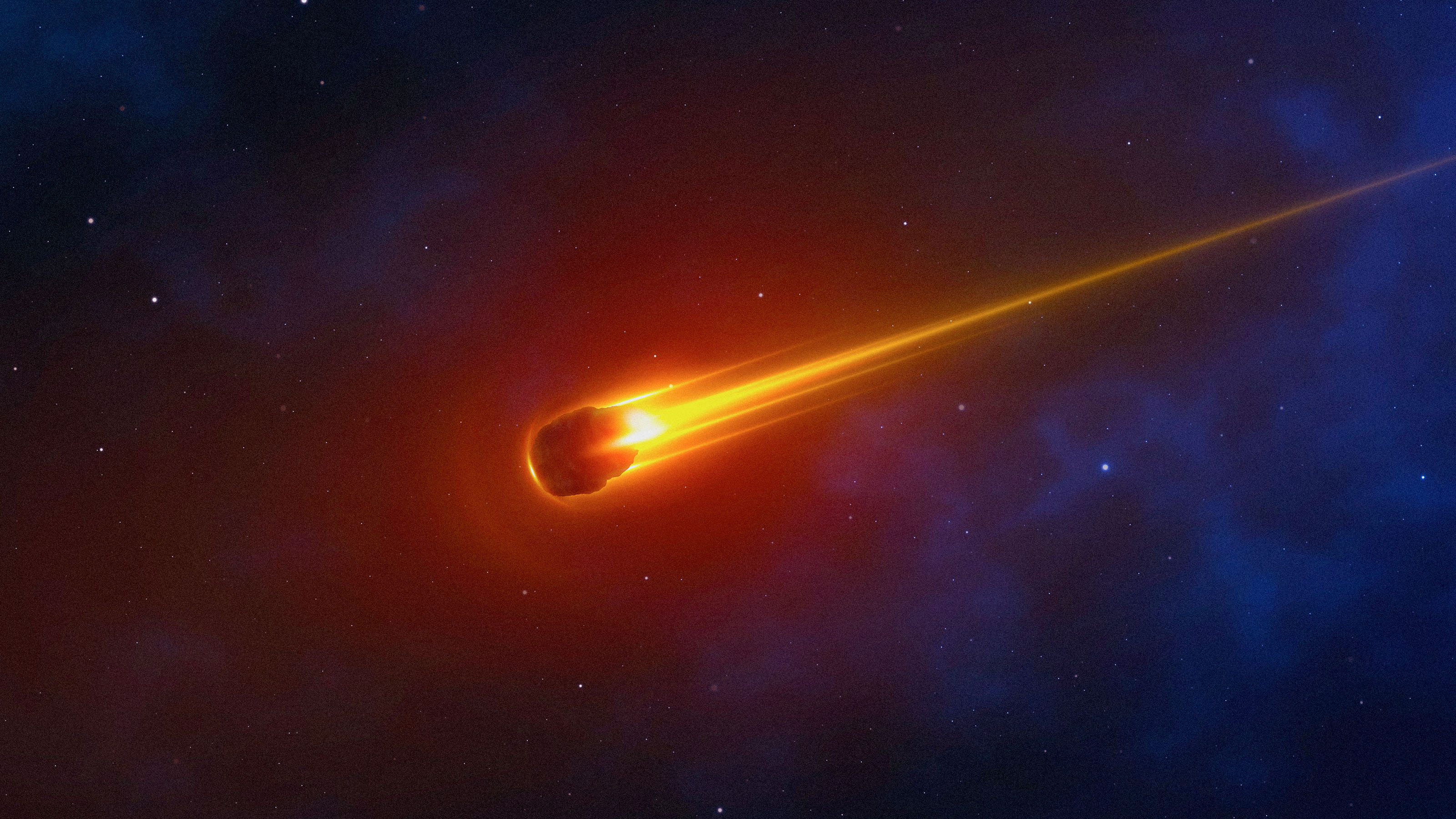We are nowhere close to defending Earth from a cataclysmic asteroid

- DART showed that we have the capability to redirect small space objects on a collision course with Earth. The successful test was a true scientific triumph.
- However, the asteroid DART hit was small. We would be almost entirely helpless in the face of a much larger asteroid, like the one that wiped out the dinosaurs.
- DART was an important step. But we are a very long way from being able to protect our planet from major impact threats.
Last September, NASA smashed a spacecraft into a small asteroid. The results were impressive, as shown in the image above.
The Double Asteroid Redirection Test, or DART, was a success as a prototype technological demonstration. But what can we say about the impact of the mission? What does it mean for our chances of defending the planet from cosmic calamity? Unfortunately, not much — not yet, anyway.
NASA’s DART was a successful mission
The spacecraft performed well. A camera aboard DART captured the scene as the craft passed by Didymos, a near-Earth asteroid. DART’s target was Didymos’ satellite, Dimorphos. The target asteroid expanded to fill the frame, and the test ended abruptly with a head-on strike.
Had the craft hit at a wide angle to the geometric center of the rock, the results could have been different. The asteroid might have rotated or wobbled without slowing its translational motion. (Think of how striking the edge of a billiard ball imparts what competitors call English, while striking the center directs the ball purely forward.) Telescopes detected giant plumes of ejected material thrown out into space, another good sign. Mass sprayed off in one direction imparts force in the other direction on the sprayer.
A few days later, NASA announced that the small asteroid’s orbit around the larger one was altered by an amount large enough to clearly measure. The orbital period dropped by about 32 minutes, from 11 hours and 55 minutes to 11 hours and roughly 23 minutes. This was at the high end of estimates going in, so it is good news.
However, that measurement alone does not tell us how well the tactic would work on an asteroid that poses a real threat — which is what we really want to know. Eventually, NASA will have more complete data, allowing researchers to examine details more carefully. For now, our answers are partial. But we can make further estimates and touch on the science behind asteroid deflection.
Interstellar gnats
A planetary defense mission works by altering the motion of an asteroid by a tiny, tiny amount. Let’s say you rolled two bowling balls down one regulation bowling lane. A gnat flies up the lane and smacks into one of the balls. The impact slows that ball by a miniscule amount, too small to reasonably measure. At the end of the lane, the balls will strike at the exact same time, to the human eye. But if the lane is 1,000 miles long, the gnat-slowed ball will arrive slightly tardy at the far end.
The lanes of space are billions of miles long, so you don’t have to hit the ball very hard if you hit it very far in advance.
Let’s say that by smashing a spacecraft into it, we reduce an asteroid’s velocity by 1/10,000 of 1 percent. The distance it travels in a day might now be reduced from, say, 864,000,000 meters to 863,999,136 meters. So, the asteroid’s expected position slows by 864 meters (0.864 km) each day after the impact. Given that Earth is over 12,000 km in diameter (nearly 8,000 miles), it takes several thousand days for the slow-down to accumulate to its intended effect: namely, allowing Earth to slip past the asteroid.
NASA hoped to slow Dimorphos by about one mile per day. In theory, this would be enough to shift an Earth impact to a near-miss, if the asteroid could be struck ten years plus a few weeks in advance of an impending collision.
What we do not know yet is whether DART’s impact slowed the asteroid more than NASA hoped. We can make some estimates by using the minimal eccentricity of Dimorphos’ orbit about Didymos — which is nearly zero, or circular — the decrease in its orbital period after impact, and NASA’s predictions. In the best-case likely scenario, the impact slowed Dimorphos by about 4 miles per day. In the worst-case likely scenario, it might have slowed it by only one mile per day. The middle-of-the-road estimate is somewhere around 2.5 miles per day. Values outside this are of course possible, and we don’t know enough yet to be sure. These numbers are in line with what NASA hoped for going in, although they are on the high end of expectations.
Re-running our simple calculations, in our best-case outcome, striking Dimorphos 2.5 years in advance would give just enough time to shift an impact trajectory to one that scraped the atmosphere but missed. In the worst case, we would need to impact it ten years ahead of time. How much protection does that afford us?
A nice start, but a long way to go
The Tunguska event was likely caused by a rock about 200 feet across. We can roughly estimate that it had less than 1/20 the mass of Dimorphos. The famous Barringer Crater in the Arizona desert, nearly 600 feet deep, was caused by a similarly sized rock of different composition. Either of these could have destroyed a city unlucky enough to sit at the impact point. Rocks of this size could be effectively deflected by DART less than a year before a predicted strike. The catch is that detecting them is very difficult. Ongoing efforts continue to discover new near-earth asteroids on a nearly daily basis. Objects like the Chelyabinsk meteor in 2013 are often detected only when the fireball lights up the sky.
Dimorphos was discovered in 2003. If it had been on a collision course for, say, 2030, we could probably prevent an impact. Didymos, about which it orbits, was discovered in 1996.
This is where the bad news starts.
Let’s say that Didymos was due to hit Earth. Its diameter is about 4.5 times that of Dimorphos. That means Didymos has something like 95 times more mass. In this case, DART would have to impact it somewhere between 190 and 950 years in advance to alter its course sufficiently. We only discovered it 26 years ago. If we needed to deflect it within a few years, we would have to hit it 100 times harder than DART hit Dimorphos. That means mass and velocity, multiplied together, must be on a scale 100 times greater than that of DART. This is possible, but it would stretch our current capabilities. We could add mass through a series of large launches, perhaps using Falcon Heavy launch vehicles. Additional engines could be launched to boost velocity. As for rocks larger than Didymos, they would pose a much greater problem.
The famous Chicxulub impactor that caused a mass extinction 66 million years ago was roughly 10,000 meters in diameter. The mass of this object — about 200,000-fold greater than Didymos — was significant enough that a spacecraft like DART would have to impact it millions of years in advance to avoid an extinction-level impact. No conceivable improved version of DART is capable of preventing such an event. For that, we would need far more powerful countermeasures. An investigation of this problem was carried out by scientists T.J. Ahrens and A.W. Harris, who analyzed the necessary countermeasures against asteroids of varying sizes. For small rocks, they conclude that a mission like DART, perhaps scaled up a bit, could be enough — as DART indeed just showed.
For rocks bigger than Didymos, but much smaller than Chicxulub, the impactor would need thousands of times more momentum. We cannot easily make a craft thousands of times faster or thousands of times more massive than DART with current rocketry technology. Nuclear weapons could impart enough push to do the job, with certain careful considerations about the composition of the asteroid, the location of the blast, how well the blast could be directed, the amount of ejecta blasted away, and so forth.
For giant objects like Chicxulub, the only presently feasible option is a truly enormous nuclear blast. A device of many megatons might give us a chance. Fortunately, we are likely to spot asteroids of this size far in advance.
DART was a useful first step toward asteroid deflection capability. However, Dimorphos is very small. We have a long way to go before we can defend against truly catastrophic collisions.





